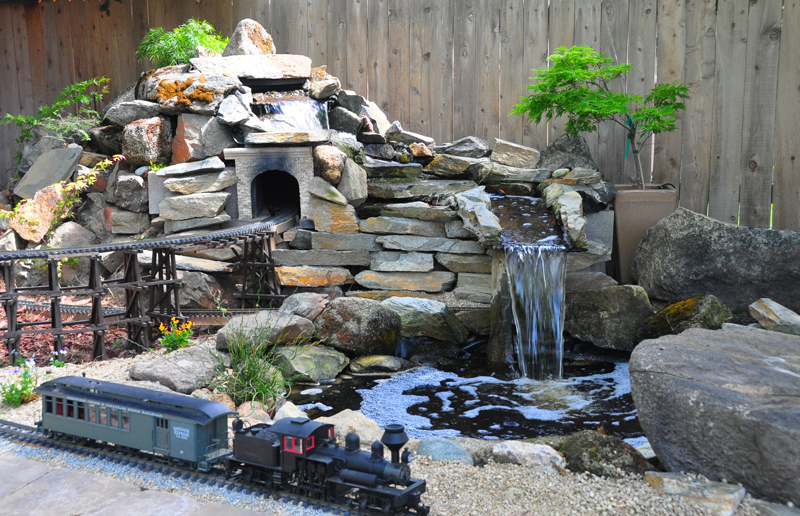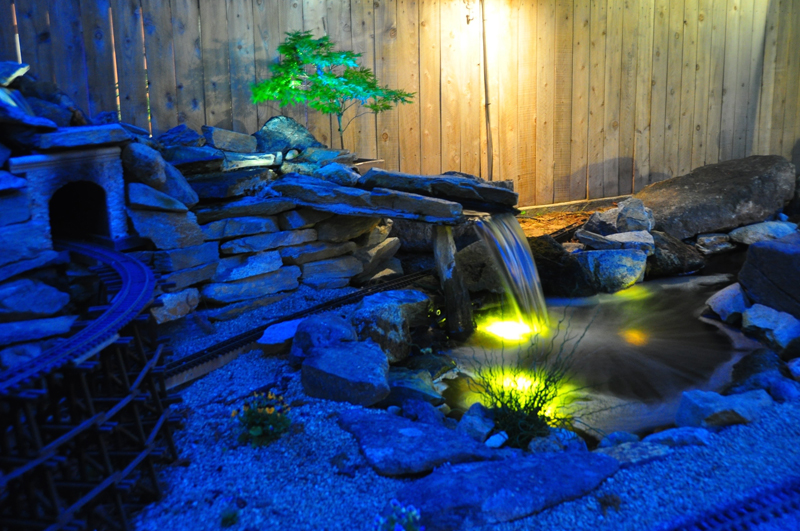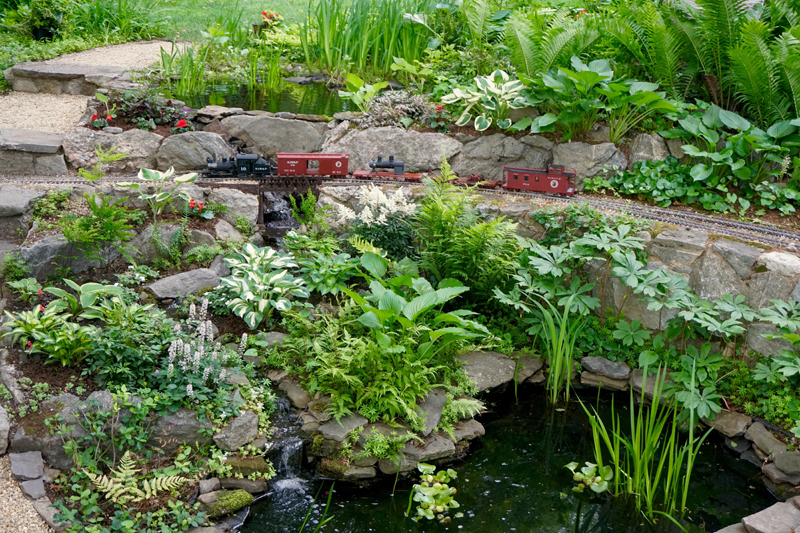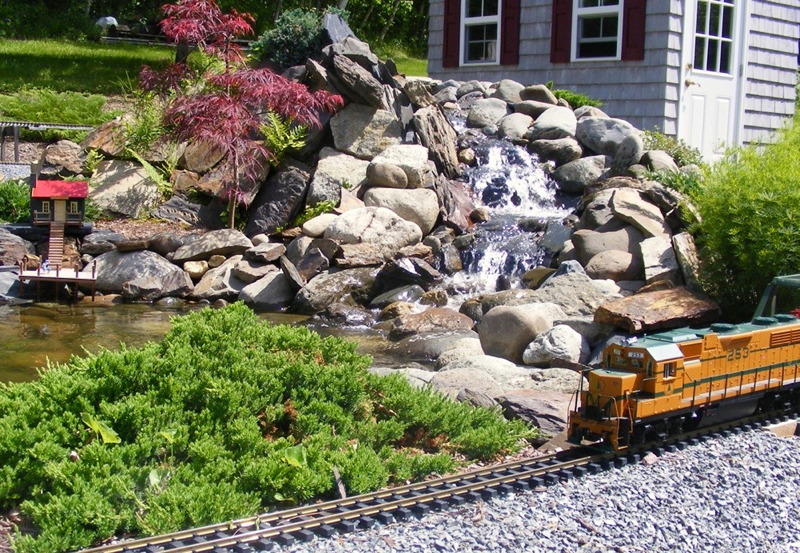What tricks can you share about integrating water into your railway?
Richard and Leslie Mynderup
Reedley California, Zone 10
Potted plants
Departing from the town of Little Paddocks, passengers are greeted by the Tallulah Ridge, rising up above. Peeking over the top, Cousin Itt (Acacia cognate ‘Cousin Itt’, Zones 9-11) always brings a smile to the passengers, and the Japanese maples (Acer palmatum, Zones 6-9) are bonsai’d to create a softening edge in contrast to the rough rock. The potted Twister dwarf curly rush (Juncus effusus, Zones 4-10) adds to the appeal of the pond. A volunteer Queen Anne’s lace (Daucus carota, Zones 3-9) greets the water before it gently pours over the spill rock into the lower pond. Potted plants, like the citronella geranium (Pelargonium citrosum, Zones 9-11) can be used to hide electrical outlets, while hopefully discouraging the visitation of mosquitoes.
The key we’ve found to keeping things in proper sizes is growing them in pots and hiding the pots with the landscape itself. This also allows for more freedom in exchanging plants depending on the plants in season, or the untimely death of a plant. If you are trying to grow plants along the sides of the waterfall, in your planning, try to create natural shelves to put pots on, or you’ll have to be creative in how you balance things. Cinder block is also an option, putting planting mix directly into the block, and growing your plants inside. Another advantage of container gardening with your water feature is in the area of irrigation. In areas where watering is restricted, drippers are an effective cure for water woes. We have developed a relationship with an expert at Belmont Nursery in Fresno, CA. After reading Nancy Norris’ book, Miniature Garden Guidebook: For Beautiful Rock Gardens, Container Plantings, Bonsai, Garden Railways, Phyllis Collier educated herself on the best plants for garden railroads and is eager to help us whenever we have questions.
We love listening to the sound of the train with the background of the sound of the waterfall. During summer months, the pond becomes a sanctuary for tiny tree frogs, which make a big sound! And as lovely as the wildlife can be, it also can be a challenge. Raccoons, egrets, and opossums have found the water feature and diminished our own wildlife, namely, the fish. We would recommend having a plan of defense before adding fish to your pond, which we learned the hard way. Also, deciduous trees can add to uptake as leaves fall in the water. We use a nylon mesh net that is easy to remove and has helped stop leaves from landing in the pond; it has been a deterrent to the local egret, too. With care, a water feature with a garden railroad is an excellent idea.
Stan and Deb Ames
Chelmsford, Massachusetts, Zone 6
Bridges and plants
Integrating water features into the garden and the railway can be a challenge. There are two sets of ponds and streams on our SJR&P railway, where we have tried to incorporate the railway and garden with our water features. A series of railroad bridges near our ponds highlight both the plants and water features.
Our sunny pond area consists of a hidden biological filter, a holding pond and a larger fishpond at the base. The fishpond was placed in the middle of a wye, tying together the pond, the railroad and the garden. One side of the wye is our large viaduct spanning the fishpond. The pond is filled with water lilies, water hyacinths, and sweet flag iris. The three sides of the fishpond are planted with small day lilies, sedums, thymes, and small leaved euonymus, which cascades over the higher rock face. Linking the two ponds, a small stream falls over a series of waterfalls. Miniature day lilies (Hemerocallis sp.), sedums and mini-hostas were planted along the stream. This set of ponds was built using sprayed gunite, so plant pockets and planting areas had to be planned from the beginning.
A meandering stream links our two shaded ponds. The railroad passes over that stream on a wooden bridge. We used pond liners for this pond complex, which provides more flexibility for planting and rock placement. Hostas, maidenhair ferns (Adiantum pedatum, Zones 3-9) and lady ferns (Athyrium filix-femina Zones 3-9) fill out the lower area. Our bog portion of the upper pond is full of moisture-loving astilbes and yellow sweet-flag iris, which wave above on sunny days reflected in the ponds.
Lincoln, Maine, Zone 5
Glue, not mortar
I bought the skimmer, an Atlantic ps4000, from pondliner.com and I think I bought the liner from them as well. I found the pump on sale at Home Depot. It pumped at a higher velocity than we needed, so we installed a ball valve to control the flow. I overlapped the liner from the waterfall onto the pond liner itself and have had no problems with any leakage at the junction.
Richard, Friedman
Sacramento, California, Zone 9
Drip irrigation
Long before water conservation became cool, I was using drip irrigation to water my garden. When I started my garden railway, I continued to do so for those reasons (I grew up where we paid for water by the cubic foot), and because only watering the plants I wanted watered reduced the weeding I’d have to do.
As my garden railway progressed, I added a pond and waterfall. Now the trains run behind the waterfall and the drip lines (though not as trouble-free as they proclaim), have functioned pretty well for over a decade. Adding electronic timers have made the process even easier. Now I get the advantages of lower water bills, and fewer weeds.

















